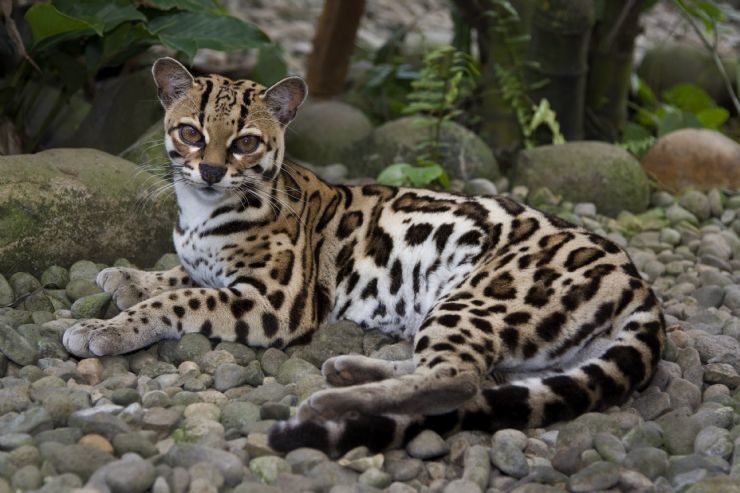
Margay on a trail in Corcovado National Park
Living in Costa Rica is a day-to-day adventure for me, and during my travels I see a lot of interesting animals. Some of these animals I am able to meet; I can get close to them, talk to them, and learn about them and their life in Costa Rica. There are other wild animals, though that I choose to stay away from because I’m afraid they might eat me! One of the sets of animals that I am never able to get too close to are wildcats, including the Margays. These adorable, small wildcats are sometimes mistaken for domestic house cats, but make no mistake – they would eat up little frogs like me pretty quickly! Margays are beautiful creatures, even from afar, and they are also highly endangered. Margays look very similar to Ocelots, but they are about the size of a large housecat – though their extra-long tails give them away. Their tails are about half the length of their bodies, and they also have very large paws (see why I stay away?). I have watched these creatures from afar for many years, fascinated by their beauty, and spent some time researching them as well. Here’s what I’ve learned about them.
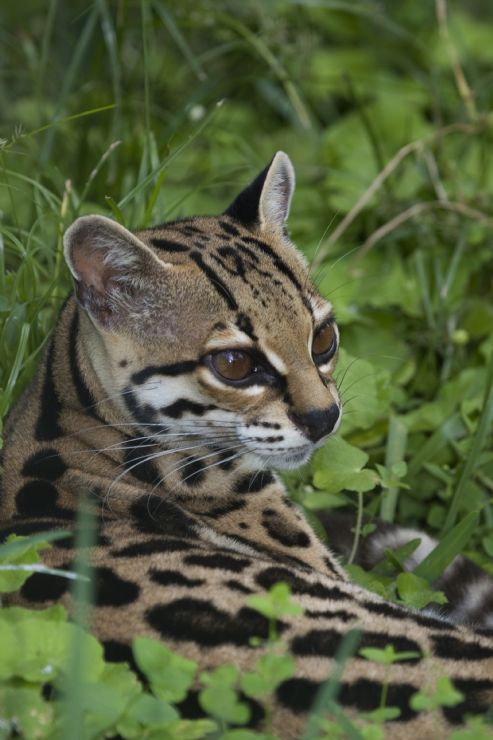
Closeup of a Margay deep in the forest of Monteverde
Meet the Margay
The Margay does not travel in packs or groups; it is a solitary animal. It is also nocturnal, so don’t expect to see it while out on a day hike. If you did see one of these cats, you’d see an animal approximately 16 inches long that weighs between five pounds and eight pounds and has large eyes and long legs. The main coloring of a Margay body and tail is brown fur that is covered with spots and streaks in dark brown or black, while the underbelly of the cat is a lighter color – sometimes even white. There have been recorded cases of black Margays, but I have not seen one myself.
7 Days / 6 Nights
Starting at $779 per person
The Margay Habitat
Margays like to live in thick forests, where there are plenty of trees for them to climb. They do not like to live in open spaces at all, and have been found not only in Central America, but also in Mexico and Northern South America. Wherever they are, they are in a forest – whether it’s a cloud forest or a tropical forest – and the denser the forest the better (we have something in common!). Sometimes it is even hard for me to spot these beautiful creatures!
The Margay Diet
And this is where I stop feeling like I have that much in common with the Margay! These cats have been known to eat bigger prey like monkeys, rodents, and birds, as well as smaller prey like lizards (gulp) and insects. They have a reputation of being curious, and it has been reported that one once tried to prey on a porcupine; it didn’t end well for the Margay!
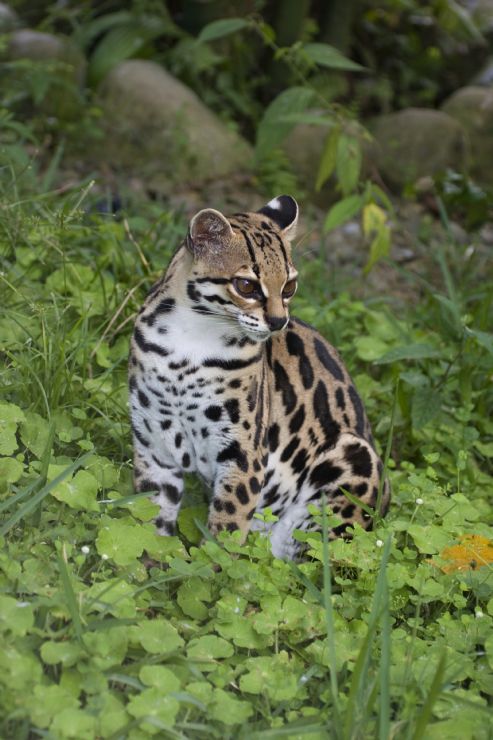
Margay (Leopardus wiedii) in a field in Monteverde
Margay Characteristics
The most notable characteristic of the Margay is their ability to climb. I've seen a margay in action (from a distance, of course) and they are great climbers! They leap up into the trees and often make small nests that they sleep in, using their urine to mark the branches. Margays must live in forests, because they truly do spend their entire lives in the trees, chasing after their tree while bounding through the treetops. They are so able in the trees that you might first think it is a squirrel hopping around. The Margay, however, is uniquely built for tree climbing, and can do so pretty extraordinary things, including scale down a tree head-first, and hanging from branches by just a single foot.
It is able to accomplish these things because it has rare ankle flexibility; its ankles can turn 180 degrees. It can also use both its front and back paws equally to grip branches. It has been recorded that they can jump up to 12 feet horizontally!
Actual Status
I’m sorry to say that the Margays are one of the most threatened cats in Central America. The International Union for Conservation of Nature moved the status of the Margay from "vulnerable" to "near threatened" in 2008.
The Margays have a small pelt, so they were not hunted as aggressively as some of the other cat species in Central America, but there are several factors that have led to their threatened status. Though not aggressively hunted, these cats were illegally hunted enough that their population was impacted. With dwindled numbers, the species was already facing trouble since they do not give birth to large litters; female Margays only have two teats, and their litters produce just one or two babies at a time.
Furthermore, their natural habitat is threatened as forests are being converted. This impacts the wild population, and has resulted in some animals being moved to captivity or protected national parks to help save them. Unfortunately, on top of having small litters, Margays just do not breed well in captivity.
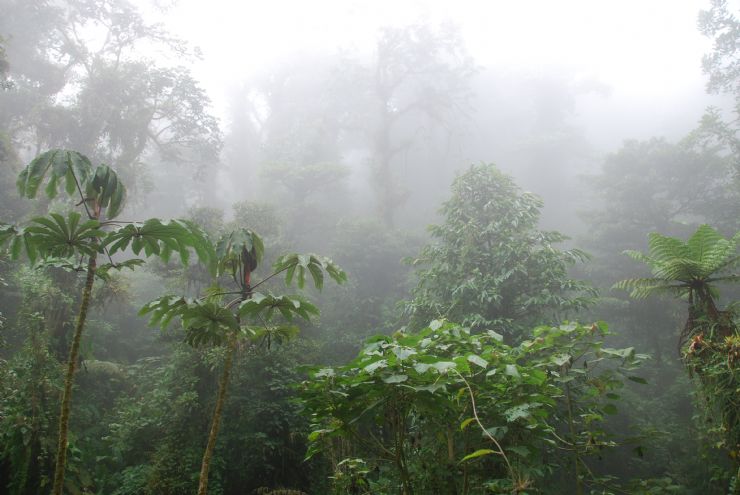
Monteverde Cloud Forest in the clouds
Margays in Costa Rica
Costa Rica is a great place for Margays to live, since there are so many forests, and there are several areas where they can be spotted, including several national parks. They are very active in these parks, in areas that are at least 3,000 m in elevation.
Corcovado National Park is located on the Osa Peninsula, a place that I love for its untamed nature. Though this park is remote, I travel there often as it is home to Costa Rica, and the world’s, only tropical primary lowland rainforest. Margays are active here, and you might be able to spot them up in the canopies.
Margays also live in Santa Rosa National Park, which is Costa Rica’s first established park. It’s not only the oldest park in the country, but it is also the biggest. The area in Guanacaste protects land that includes a large chunk of the world’s last tropical dry forest.
If you'd rather visit a more tropical locale, head to the Monteverde Cloud Forest Reserve in the Central Highlands. As one of the most well-preserved cloud forests in the entire country, there is just so much to see and do here! You'll notice the dense greenery the moment you arrive here, so of course there are plenty of Margays hiding up in the canopy. You can even go on a canopy tour or zip line through this national reserve.
La Selva Biological Station was originally created for scientific purposes, but it has since been opened to the public. From the San José Costa Rica international airport, you can reach this attraction in the Northern Lowlands of the country from Guapiles Highway and Highway 4. You can go on a walk during the day and at night here, but if you want to catch some Margays in action, you'll probably be better off going at nighttime. I actually have some relatives that live here too! Don't forget to look in the trees to spot the red eyes of tree frogs like me.
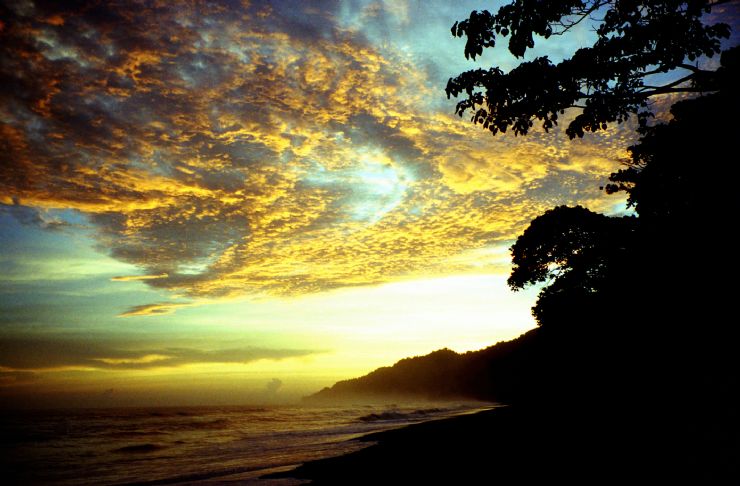
Sunset at Corcovado National Park

